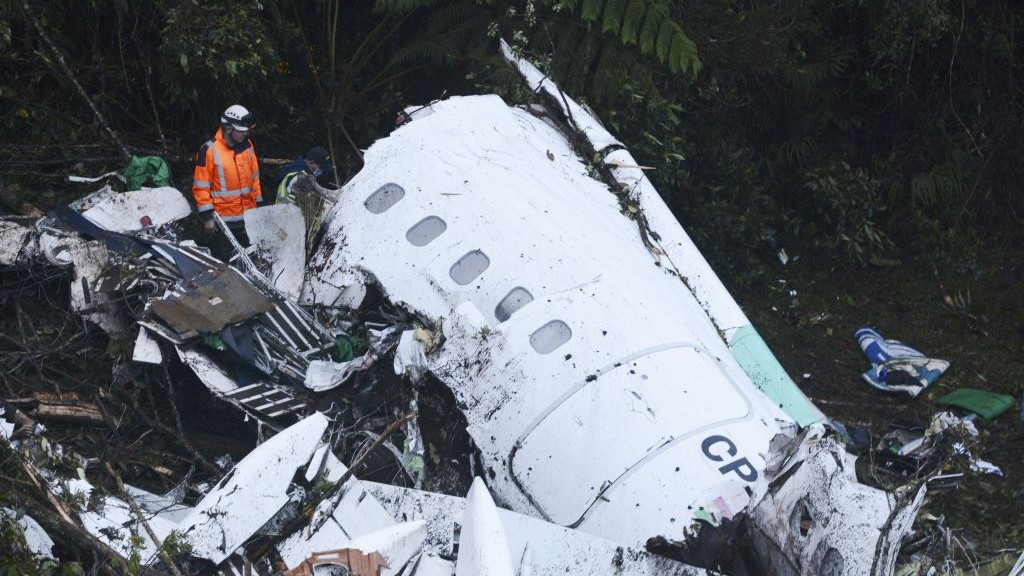Historical Overview of Plane Crashes in Brazil: Brazil Plane Crash Type

Brazil, a country with vast geographical expanse and a thriving aviation industry, has unfortunately witnessed its share of tragic plane crashes throughout its history. These incidents have left a lasting impact on the nation, highlighting the importance of aviation safety and the need for continuous improvements in the industry.
Timeline of Significant Plane Crashes
This section delves into a timeline of significant plane crashes in Brazil’s history, highlighting the types of aircraft involved, the causes, and the resulting casualties.
- 1949: The first major air disaster in Brazil occurred on August 2, 1949, when a Panair do Brasil Douglas DC-4 crashed near the city of Belém, killing all 41 passengers and crew members. The cause of the accident was attributed to a combination of factors, including engine failure and poor weather conditions.
- 1961: On July 16, 1961, a Varig Lockheed L-188 Electra crashed near the city of São Paulo, killing 33 passengers and crew members. The crash was caused by a mechanical failure in the aircraft’s tail, leading to a loss of control.
- 1973: On September 3, 1973, a Varig Boeing 707 crashed in the Andes Mountains in Chile, killing 61 passengers and crew members. The crash was caused by a combination of factors, including a mechanical failure in the aircraft’s hydraulic system and poor weather conditions.
- 1982: On August 12, 1982, a Vasp Boeing 737 crashed near the city of São Paulo, killing 137 passengers and crew members. The crash was caused by a combination of factors, including pilot error and a mechanical failure in the aircraft’s rudder.
- 1989: On September 19, 1989, a Transbrasil Boeing 737 crashed near the city of Rio de Janeiro, killing 101 passengers and crew members. The crash was caused by a combination of factors, including pilot error and a mechanical failure in the aircraft’s engines.
- 2006: On July 17, 2006, an TAM Airlines Airbus A320 crashed in São Paulo, killing 199 passengers and crew members. The crash was caused by a combination of factors, including pilot error and a mechanical failure in the aircraft’s brakes.
Types of Aircraft Involved
This section discusses the types of aircraft involved in these crashes, providing insights into the prevalence of certain models in the Brazilian aviation industry.
- Douglas DC-4: This four-engine propeller-driven aircraft was widely used by airlines in the 1940s and 1950s. The DC-4 was involved in several crashes in Brazil, including the 1949 Belém crash, which marked the first major air disaster in the country.
- Lockheed L-188 Electra: This four-engine turboprop aircraft was also popular with airlines in the 1960s. The Electra was involved in the 1961 São Paulo crash, which highlighted the importance of aircraft maintenance and safety protocols.
- Boeing 707: This four-engine jet airliner was a mainstay of long-haul flights in the 1960s and 1970s. The 707 was involved in the 1973 Andes Mountains crash, highlighting the challenges of flying in mountainous terrain.
- Boeing 737: This twin-engine jet airliner is one of the most popular aircraft in the world, and it has also been involved in several crashes in Brazil, including the 1982 São Paulo crash and the 1989 Rio de Janeiro crash.
- Airbus A320: This twin-engine jet airliner is another popular aircraft model, and it was involved in the 2006 São Paulo crash, which led to a significant review of aviation safety regulations in Brazil.
Common Causes of Plane Crashes
This section explores the common causes of plane crashes in Brazil, highlighting any recurring patterns that have contributed to these tragic events.
- Pilot Error: Pilot error is a significant factor in many plane crashes, including the 1982 São Paulo crash, the 1989 Rio de Janeiro crash, and the 2006 São Paulo crash. These incidents highlight the importance of proper pilot training, cockpit procedures, and fatigue management.
- Mechanical Failure: Mechanical failure in aircraft components is another common cause of crashes. The 1961 São Paulo crash, the 1973 Andes Mountains crash, and the 2006 São Paulo crash all involved mechanical failures that contributed to the accidents. These incidents highlight the importance of rigorous aircraft maintenance and inspections.
- Weather Conditions: Adverse weather conditions can also play a role in plane crashes. The 1949 Belém crash and the 1973 Andes Mountains crash both occurred during periods of poor weather, highlighting the importance of weather forecasting and flight planning.
- Terrorism: While less common, acts of terrorism have also been responsible for some plane crashes in Brazil. The 1973 Andes Mountains crash was initially believed to be caused by a bomb, but this was later ruled out.
Statistics on Fatalities and Injuries
This section provides statistics on the number of fatalities and injuries from plane crashes in Brazil, highlighting the devastating impact of these events.
- Total Fatalities: The total number of fatalities from plane crashes in Brazil is estimated to be in the thousands, with some estimates exceeding 10,000. However, accurate statistics are difficult to obtain due to the lack of comprehensive data collection and reporting.
- Fatalities Per Crash: The number of fatalities per crash has varied significantly over time, with some crashes resulting in only a few casualties, while others have resulted in hundreds of deaths. The 2006 São Paulo crash, which claimed the lives of 199 people, is the deadliest plane crash in Brazilian history.
- Injuries: In addition to fatalities, plane crashes have also resulted in numerous injuries. While exact statistics are difficult to obtain, it is estimated that thousands of people have been injured in plane crashes in Brazil.
Factors Contributing to Plane Crashes in Brazil

Plane crashes are tragic events that have a devastating impact on lives and communities. While aviation safety has significantly improved over the years, plane crashes still occur, and understanding the contributing factors is crucial for preventing future accidents. In Brazil, a variety of factors can contribute to plane crashes, ranging from human error to environmental challenges.
Human Error
Human error plays a significant role in aviation accidents worldwide, and Brazil is no exception. Pilot fatigue, inadequate training, and poor decision-making can all lead to crashes.
- Pilot Fatigue: Long working hours, insufficient rest, and demanding flight schedules can lead to fatigue, which can impair pilots’ judgment and reaction time.
- Inadequate Training: Lack of proper training and experience can contribute to errors in judgment and handling of aircraft.
- Poor Decision-Making: Pilots may make poor decisions in the face of challenging situations, such as adverse weather or mechanical problems.
Mechanical Failure
Mechanical failures can also contribute to plane crashes. These failures can involve a range of components, including engines, avionics, and control systems.
- Engine Failure: Engine malfunctions can lead to loss of power and control, potentially causing a crash.
- Avionics Malfunction: Problems with navigation systems, communication equipment, or other avionics can disrupt flight operations and lead to accidents.
- Control System Failure: Failures in control systems, such as the flight control surfaces or hydraulic systems, can compromise the aircraft’s ability to maneuver safely.
Weather Conditions
Brazil’s diverse geography and climate present unique challenges for aviation. Severe weather conditions, such as thunderstorms, turbulence, and low visibility, can significantly increase the risk of accidents.
- Thunderstorms: Thunderstorms can produce strong winds, heavy rain, and lightning, which can pose serious threats to aircraft.
- Turbulence: Turbulence can cause sudden changes in altitude and airspeed, making it difficult for pilots to maintain control.
- Low Visibility: Fog, rain, or other weather conditions can reduce visibility, making it difficult for pilots to navigate and land safely.
Air Traffic Control Procedures and Infrastructure
Effective air traffic control procedures and infrastructure are essential for maintaining aviation safety. However, challenges in these areas can contribute to accidents.
- Inadequate Air Traffic Control Systems: Outdated or insufficient air traffic control systems can lead to delays, miscommunications, and potential collisions.
- Limited Infrastructure: Insufficient runway capacity, outdated navigation aids, and limited maintenance facilities can contribute to safety risks.
Airworthiness Standards and Maintenance Practices, Brazil plane crash type
The airworthiness of aircraft and the quality of maintenance practices are crucial for preventing accidents.
- Inadequate Airworthiness Standards: Lax airworthiness standards can allow aircraft with potential safety issues to operate, increasing the risk of accidents.
- Poor Maintenance Practices: Inadequate maintenance, including delays in inspections and repairs, can lead to mechanical failures and accidents.
Geographical and Environmental Challenges
Brazil’s vast and diverse geography presents unique challenges for aviation.
- Mountainous Terrain: Flying over mountainous terrain can pose challenges for pilots, especially in areas with limited visibility.
- Tropical Climate: Brazil’s tropical climate can lead to severe weather conditions, including thunderstorms, turbulence, and heavy rainfall.
- Dense Vegetation: Dense vegetation can obscure landing areas and make it difficult for pilots to navigate.
The tragic Brazil plane crash type serves as a stark reminder of the fragility of flight. While we often focus on the technical aspects of aviation, it’s important to remember that human error and unforeseen circumstances can also play a role.
Sometimes, as seen with the recent ground stop at NYC airports , safety protocols are implemented to prevent potential disasters. This emphasizes the constant need for vigilance and a commitment to ensuring the highest safety standards in aviation, no matter the scale of the operation.
The tragedy of the Brazil plane crash serves as a stark reminder of the fragility of life and the importance of safety measures. Just as the investigation into the crash seeks to unravel the causes, we can learn from the fox debate in the realm of politics.
By understanding the different approaches and strategies employed, we can better navigate the complexities of our world and strive for solutions that prioritize the well-being of all.
